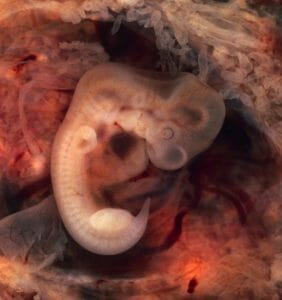Atavism Definition
An atavism is the phenomenon in which a phenotypic trait reappears in an organism after a period of absence. An atavism refers to a trait that is not present in the immediate predecessors of an individual, although was existent in its ancestors.
This is possible due to the way genes behave throughout the evolutionary process. When phenotypic traits are lost during the process of natural selection, the genetic information in the DNA that codes for them is not necessarily lost and instead may just be inactive. This means that the genes can be reactivated, even after lying dormant for many generations.
Atavisms differ from vestigial structures. These are phenotypic features present in all members of a species, which in the organism’s evolutionary past have been necessary for survival, but are no longer used or functional in modern individuals.
Examples of Atavisms
The Human Tail
There are several scientific incidences of human babies being born with a tail that contains cartilage and vertebrae, called a “caudal appendage”.
All human babies grow in the womb with a small prenatal tail—a “throwback” feature of our evolutionary roots as tree-dwelling primates. The genes which control for the growth of the tail are normally switched off as a result of gene regulation and the tail is reabsorbed into the tissues of the embryo. However there are instances in which this gene regulation malfunctions and the tail continues to grow beyond the stage of embryonic development.

The image shows a human embryo in the womb. The tail is visible. Although the genes, which control for the development, are usually deactivated by gene regulation, sometimes this fails and a human is born with a tail.
Chickens with Teeth
Through inspecting the beaks of un-hatched embryos, scientists have discovered several occurrences of chicken embryos that exhibit evidence of tooth formation, and even embryo chicks with full sets of developed teeth! To matter matters stranger, the developing teeth are similar to those found in their closest living relatives…crocodiles!
Bird lost their ability to make teeth around 80 million years ago, however modern chickens still possess the gene that is responsible for causing odontogenesis (tooth formation) though the gene has long been deactivated. Scientists have named this gene Talpid2.
Although Talpid2 is lethal, meaning gene expression causes chicks to never successfully hatch, the discovery has provided support for atavism. In order to prove the hypothesis, biologist Matthew Harris engineered a virus that could mimic the molecular signals of the gene mutation. When implanted into normal healthy chickens they briefly developed the same cone-shaped crocodile teeth, although they were quickly reabsorbed into the tissue of the beak.
Dolphins with Legs
In 2006, a dolphin was caught near Japan which, as well as possessing the two front flippers that all dolphins have, had a pair of small and symmetrical pelvic flippers closer to the tail.
This is an example of an atavism; the fins are reminiscent of hind legs so they appear to be a “throwback” phenotype from the ancestor of dolphins that could walk on land. As mammals, the cetacean evolutionary lineage can be traced back to land mammals such as hippos, and the discovery of the dolphin with four limbs suggests genes that code for limb growth are still present.
Quiz
1. Atavisms are caused by:
A. New mutations in DNA
B. Reactivation of dormant genes
C. An organism’s attempt to adapt to an environment
D. Reuse of a vestigial structure in an organism
2. Why do chickens grow teeth similar to those of a crocodile?
A. It’s the standard shape of a tooth
B. The shape is caused by a random mutation
C. They share a common ancestor
D. It is the best shape adapted to their diet
References
- Adams, J. Shaw, K. (2008) Atavism: Embryology Development and Evolution. Nature Education. 1(1) 131
- Baruchin, A. Mahler, D. Hauben, D. Rosenberg, L. (1983) The human caudal appendage (human tail). British Journal of Plastic Surgery. (36) 120-123
- Dolphin with four fins may prove terrestrial origins (2006) National Geographic News. Retrieved from: http://news.nationalgeographic.com/news/2006/11/061106-dolphin-legs.html
- Harris, M. Hasso, S. Ferguson, M. Fallon, J. (2006) The development of archosaurian first-generation teeth in a chicken mutant. Current Biology. 21; 16(4): 371-7
- Mukhopadhyey, B. Shukla, R. Mukhopadhyay, M. Mandal, K. Haldar, P. Benare, A. (2012) Spectrum of human tails: A report of six cases. Journal of Indian Association of Paediatric Surgeons. 17 (1) 23-25
- Mutant chicken grows alligatorlike teeth (2006) Scientific American. Retrieved from: https://www.scientificamerican.com/article/mutant-chicken-grows-alli/
- Oshumi, S. Kato, H. (2008) A bottlenose dolphin (Tursiops truncatus) with fin shaped appendages. Marine Mammal Science. 24. (3) 743-745
- Shad, J. Biswas, R. (2012) An infant with a caudal appendage. BMJ Case Reports. Bcr1120115160.
- Surprise: Chickens can grow teeth. (2006) Live Science. Retrieved from: http://www.livescience.com/7051-surprise-chickens-grow-teeth.html
- What our tails tell us. (2007) Los Angeles Times. Retrieved from: http://articles.latimes.com/2007/feb/15/opinion/ed-tails15
Atavism
No comments:
Post a Comment